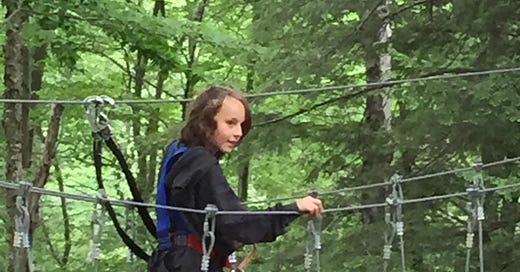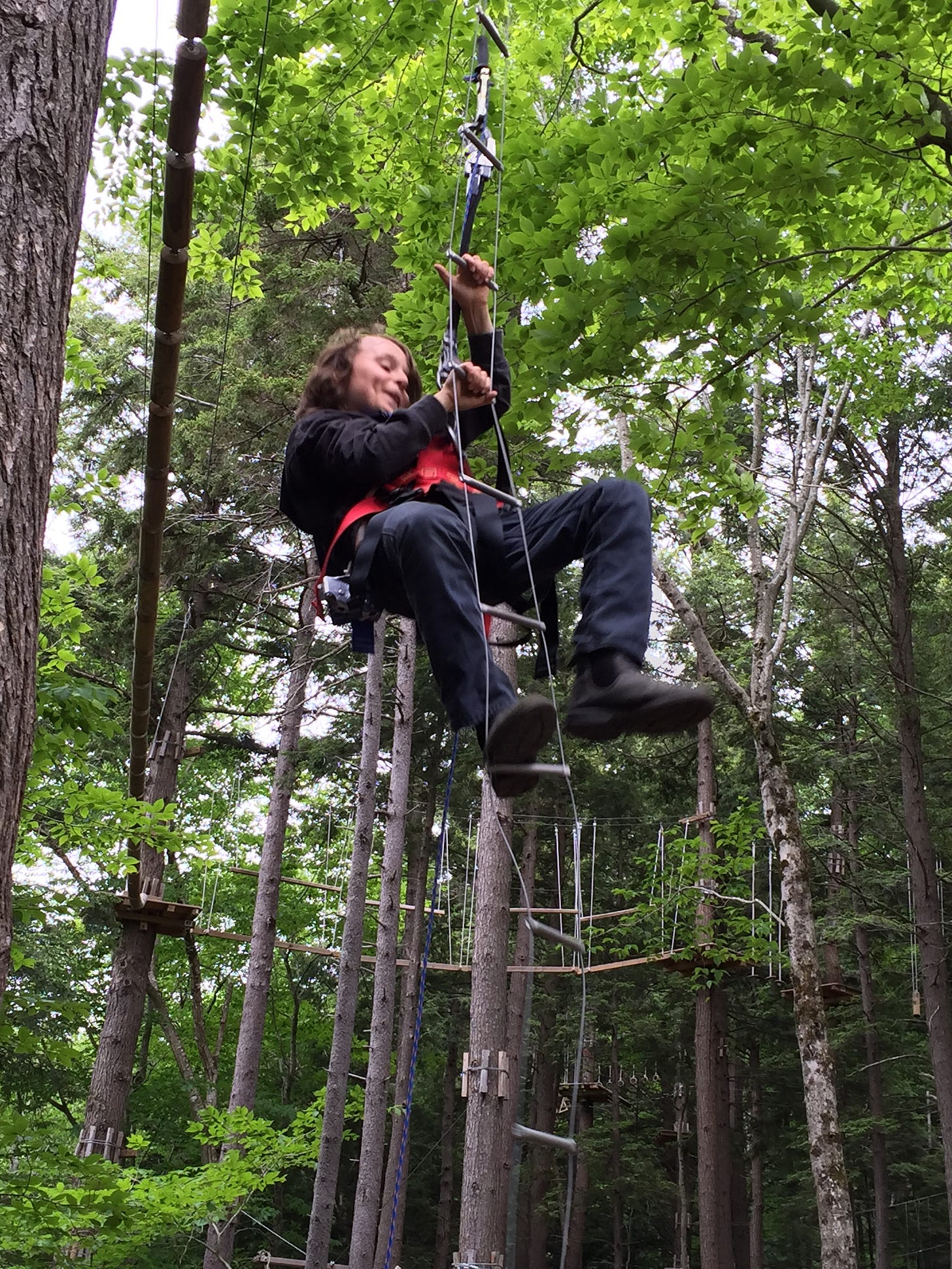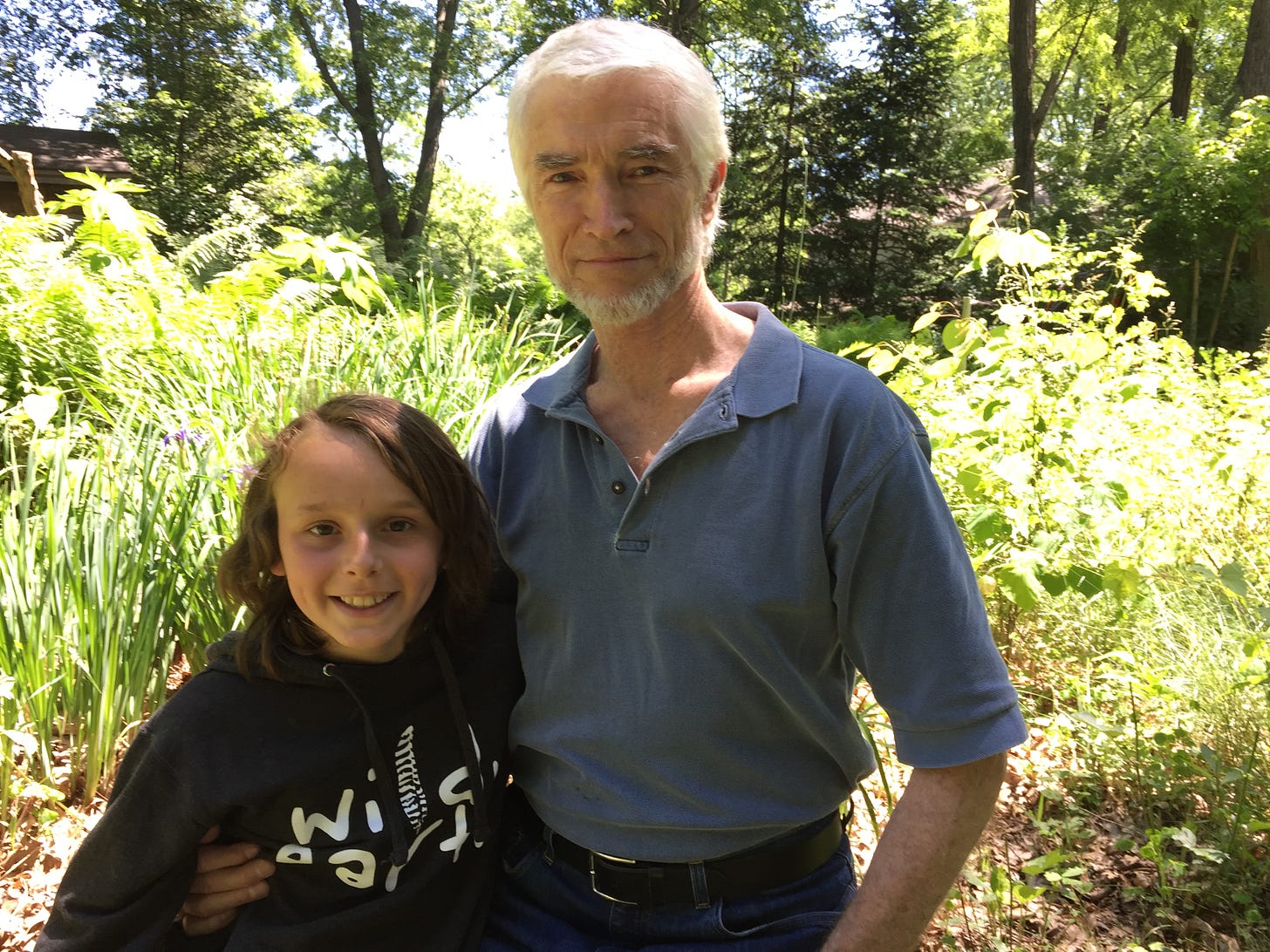The Beginning:
It was to be a once in a lifetime adventure. After all, it was the traditional nine-year-old trip—and Ezra would be nine for only one year.
An adventure must have certain ingredients. To begin, we need some thing or some place new, unexplored, even exotic (internal or external might do). A backbone with skeleton will help—some framework, itinerary, plan. Yet a measure of the unexpected is a must; an unplanned path, an elemental shock, a strike to one’s center of gravity, something about which to laugh later, or lament, or savor. Yet much of an adventure lies in the unknown as it unfolds before us.
Yesterday we packed my silver SUV, nick-named “Silver”, with camping gear, entertainment (consisting of a giant frisbee and a book of stories by Tom Brown, The Tracker) and set off north, for our fist leg of the trip, Vermont, toward thinning civilization.
The family homestead sits on ten acres, half-way up the state of Vermont; a quiet, deep New England setting, overlooking the “trout pond” that my brother Stephen, father Walt, and I built near forty years ago. It was the same year Stephen and I built the treehouse, spanning three Hemlock trees, sixty feet high in the forested, ridge-top north-west corner of the property. Not so many visitors made it to those tree-tops, especially since the only way up was to use branches that, in the lower section, had already been dead for years. But “dead” has a different meaning for Hemlock trees. Those dead branches supported us for years, and held their strength even decades after two of the tree trees fell, taking down the tree-house. Some folks we hooked up in climbing harnesses to keep them safe, then offered a thrilling rappel back to earth. Steve, Dad, and I were three eager-beavers, building, as beavers do.
It is a familiar place, this home, though its mood can change as much as any person I’ve ever known—reflecting my inner state, along with that of the beings and the elements at play at any moment. Dark, bright, heavy, light, the same scene can morph from one hour to the next.
A word, a feeling, comes to mind—surround. In the depth of summer the many shades and shapes of green can almost feel claustrophobic, cloying, the lush intensity reflecting the desperate need to grow, and to do it fast, while the season is favorable.
In the heart of winter, when snow falls with a magnificent soft flow to earth, seen in every direction through the many large windows, it seems a space craft is thrusting lazily though the white flakes.
In spring we are surrounded by the push of new life, from earth, from limb, from the pond, the air—each bit of force reflected within, my chest expands without growing in size.
In fall, when outrageous colors blast the senses in this perfect New England cosm, it’s difficult to believe it’s real, that it is freely given, and will soon be taken away. There are no other houses or buildings visible from this location. When I am in it I am surrounded by the full force of the tableau that nature has set before me, from a four foot depth of snow to ninety degree summer days swimming in the pond. Any of it can be a blast or a bother. That part depends on me.
Ezra has been having adventures here since he was a baby. As he has grown, so has the wildlife around the pond. Bush, grasses, pines, birch, and poplars ring the near half-acre pond, appearing as if by spontaneous generation. None of it is introduced by we humans. Our job is more to keep the growth in check, lest it turn completely wild. This would not be a problem, but that we are looking for a symbiosis, so that we might touch, smell, taste the wild, and hold a bit of grip on our civilized comforts as well. New life thrives within, around, and above the glassy pond surface.
Above it all rests a wooden sign, quietly passive, sitting through time, carved with the name Waltz Pond—honoring our father Walt who helped build the pond—a most loving and gentle spirit, and the competitive level dancing he and our mother, Mary, engaged in when I was too young to notice.
This is our starting-point. This is day one of Ezra’s “nine-year-old trip”.
Arial Acrobatics:
We set out the next morning. “Where are we going, Grandpa?” “That I’ll keep as a surprise.”, I offered as Ezra and I headed that first day toward the adventure park at Loon Mountain in New Hampshire.
The day was heavy with gray, the air tipping back and forth on the sharp edge of drizzle. It worked to our advantage—shorter lines, less competition, more negotiating room. “He’s too young”, was repeated. “You need to be fourteen to do the high-ropes course. He’s only nine.”
“Will he be clipped in so that he cannot fall?” I asked. “Yes, but he’s not tall enough either.” “Will he be clipped in so that he cannot fall?” I asked again. The opposing force was weakening. I turned to Ezra. “Are you ready?” Ezra is always ready—ready for fun, for adventure, to climb anything around him. As soon as his arms and leg came under his control he was climbing windows, furniture, adults—anything that looked tall. A question could often be heard resounding around the house, “What has that baby gotten into now?” We knew to look high and low.
He stood with a relaxed confidence, eying the tall ticket-takers, and the ropes and challenges, several of his heights above his head. “Sure” is Ezra’s reply, with just a hint of doubt. “Grandpa can you join me?” I stand there silently hoping there is an upper age limit, I being seventy. “Of course”, is my spirited reply.
The ladder we climb is frighteningly narrow, aiming toward the sky, ending at a perch well off the ground. But as we focus on the next rung before us, the tight view magnifies the size of the metal pieces we climb, like an eagle tracking a mole hundreds of feet below—not enough there to inspire easy confidence, but solid enough for our minds to accept and our hands to grasp. There seems a lightness of air to the lungs, though, as if climbing into the clouds, almost too thin for breath, a casualty of that oft dancing duo of anxiety and excitement. We tame it.
The first series of hurdles consists of moving loop-de-loop across ropes like monkeys: reach-step-cross, reach-step-cross. We are at the “friendly green” level, harder than yellow, which we by-passed, sneered at even, though we still haven’t hit the hard stuff. But as Ez keeps proving himself, we move on to the more difficult blues, stepping for example, on the ends of dangling logs that want nothing more than to tip and dip and spill each passer-by off. I follow him a little longer until he is firmly established in the most difficult level, the blacks. Then I let him track the arial course on his own. He is on a roll and needs no more confidence boost from me. Like a first stage fuel pod for a rocket, I am jettisoned, forgotten, my propulsion finished.
Ezra comes to a stretch that looks like a stopper. He won’t make it through. He pauses, views it thoughtfully as his easel, his body and will forming the brushes and all the colors he needs, or could want, to paint his masterpiece. He starts tentatively, then with growing confidence, leaving step after step behind him, it is done. A beautiful work, witnessed by a few.
There are moving triangles to step into, cables that want to tip you backward, and other clever hinderances. He then encounters a challenge clearly designed for taller bodies. He surveys. I stand below. I can only will him forward, wish him success. He cannot reach, it is clear. He takes it all in, makes his internal assessment. His eyes move upward. He reaches up to the steel cables that hold each challenge in place, that stabilize the entire arial playground. He grabs with both hands, then with both legs, and proceeds, at a crawl, up-side-down, morphing into the animal he needs to be, until across. Are there rules to this endeavor? Yes ! One. Make it across, alive. Ezra completes the last course, failing at none, including a few exhilarating zip-lines, embarrassingly outshining some young adults who entered after him.
The young attendees who originally wanted to block his access, looking on with a measure of awe, ask, “Can we hire him?” “He’s too young”, I say. “He’s only nine.”
The Tradition:
This trip with Ezra is the third in the line of this tradition, sequential according to incarnation on this earth. We would be a duo for this time of travel, and whatever energy or activity we might create will be our duet. I am cranked, running on a fully-charged battery and I can see that he is as well, as we poke the mileage-meter to zero, smile into each other’s eyes, and roll out the driveway in New Paltz. Here, now, we begin.
Two years earlier I traveled with his brother Asher on his nine-year-old trip, exploring Maine and Nova Scotia, ocean and mountain. Twenty-five years before that, the tradition started, not then as a tradition, simply as a great adventure—a BMW motorcycle trip from the east coast to the Rockies, Jason and I cruising much of the summer together. As Ez and Ash approached nine, I explained that our adventure would not involve a motor-cycle, and it would not cross the country. With the levels of distracted driving that goes on these days, I want a lot of metal surrounding me, a sphere of large metal roll-bars. Yet adventures can take many forms, and we would find ours.
As I envisioned this trip with Ezra, I knew it would be very different from that of either his father or brother. Where Asher would read to himself during quiet moments, or read to me from Calvin and Hobbs ( a delight for me), Ezra would talk, ask questions, or engage in investigative actions of all sorts, usually requiring at least a minimal monitor from me—like commandeering my can of shaving cream and creating foam sculptures in the middle of the campground automobile roads, then demanding that I check each one carefully, to admire its creation. If there was any down-time between our major activities, where Asher and I might rest, Ezra would whip out the giant frisbee. “Come-on Grandpa. Let’s play”. I was a ragged yet happy companion.
As I planned and researched an itinerary for our trip, a theme began to materialize. We would be on a quest for the elusive Common Loon of the Eastern US and Canada—a reclusive yet very cool creature, with an other-worldly sound, if one is fortunate enough to hear it. A Loon connection, in any form, would count as a score. Our external target added to our inner excitement, and we were ready to play, adding a layer of depth to our travels.
As we searched and had our tales to tell, we would be characters in our own story. unfolding all around us, and within. I see that this nine-year-old is capable of engaging the interesting mirror of living an adventure and reflecting on it at the same time, leading to layers and depths of curiosity.
I the Ranger:
There are some who call me “The Ranger”.
When high-summer rolls around each year, I join my brother and two friends for a week at the Vermont homestead. We hike and hang and explore, and essentially, be together. There is music and food and cocktail hour overlooking the pond, mixed with daily excursions. Hiking is one of our central adventures, whether it be the Green Mountains of Vermont or White Mountains of New Hampshire.
I hike much, throughout the year, in several states (both inner and outer). It is always a pleasure to bring a new surprise find, a treasured hike to the group. Mt Pisgah, at Lake Willoughby in the Northern Kingdom in Vermont, and Sugarloaf Mt in New Hampshire, near Grafton Notch, have, for example, been regular favorites, where Bruce, Ringo, Stephen and I have often journeyed. Brother Stephen plays the role of Captain during our summer retreats, coming up with tantalizing itineraries including hikes, eateries, historical sites, and oddities, like the quiet resting pace of the familiar puppets of Bread & Puppet infamy—and always, the reliable conductor in his most comfortable Passat touring-auto.
As the Ranger, I am the finder of trails and keeper of the homestead grounds. I can be often found tending stone steps, seeing to the safety of guests, carving trails across the ten-acre property, and maintaining the trails with chain-saw, rake, or hoe.
When I hear the word Ranger I often recall one of my favorite childhood heroes, the Lone Ranger. He was always a force for good, battling wrong-doers at every turn in the trail. And as he trailed off at the end of each program we’d hear: “…a fiery horse with the speed of light, a cloud of dust, and a Hi-yo Silver, Away!—The Lone Ranger rides again.”
Boarder Crossing:
An adventure is determined not only by where we go, but by what we leave behind. Driving out the driveway in New Paltz, we left much behind—the familiar, the comfortable, the tonnage of life’s collection. Today we leave behind much of what has glommed onto us, as well as the country of the USA.
Our first score of our Loon hunt, yesterday at Loon Mountain Adventure Park, was an easy find. It was on the map, and it invited strangers, with their purses of course. Score one! for the Loon search.
But I know of no further maps for our quest—no treasure maps, no X marks the spot. We will at this point simply venture into Loon territory, in USA and Canada, then see what we see. We might score nothing more, but what would an adventure be without a bit of the unknown, of sweet tension, of potential failure?
Our adventure takes us north once more, toward even thinner civilization. We lean back in our rocket seats, Sliver that is, and dial in to the road ahead.
Crossing the boarder into Canada is easy, and in short time we are aiming deeper north into Quebec. A wild and beautiful landscape surrounds us as we travel toward our destination, Parc National Du Mont Orford.
We survey the camp-site, on the shore of the vast and quiet Lake Stukely. A lively discussion on the merits and detractions of numerous tent locations leaves us, eventually, with an agreed-upon best option. We work with energy.
We can leave all other components of “home” at home, and feel at home here, with each other, a temporary creation that can hold us like a nest in a tree—though in a tree is not where we’ll find a Loon nest.
What Currency is Required?:
We awake to a bright sunny day. We are aiming to hike the 9KM trail to the top of Mont Chauve. The currency required (that which is able to maintain the flow, the current), will be energy and attitude. We begin with a hefty breakfast cooked over the campfire. Eggs, sausage, and a couple flap-jacks should charge our batteries well.
The hike is delicious, with glorious views at the top. Ezra does well, stamina not a problem. He exhibits at times a common condition I see in young students I’ve worked with and friends around his age. They complain, mostly through boredom, during the long effort stages, then go running off joyfully like a wild animal in the woods, which they do morph into.
“Don’t go out of sound range or my voice”, I holler as he runs down the trail. And I add, as he is about to disappear around a turn, “Don’t pass any forks in the trail”. Those are my two rules. My tether is long, and it works well, nearly invisible to him, as his long hair trails behind him, feet flying down the path, breath slapped with the oncoming air.
We stop for a snack at Peabody’s General Store on the way back to camp. There we discover that Canadians don’t use paper one-dollar bills for their currency. They use coins. Stamped on one side of each one-dollar coin is, yes, a Common Loon. There it is, Score Two!. The coins are fondly called Loonies. We see that they also have two-dollar coins. Because of their value of two, the are called Toonies. Loonies and Toonies. Perfect. We’ll take a score in whatever form it arrives.







Awesome Glenn!
What an adventure and tradition. I love that you knew exactly where to start the adventure with Ezra, at Loon Mountain Adventure Park...a place where he would surely love to be and be challenged by. Then letting the "loon" theme evolve...
Of course I love your description of the "boy's week" in Vermont as well. Here's to many more adventures with "The Ranger". Hi- Ho Silver!